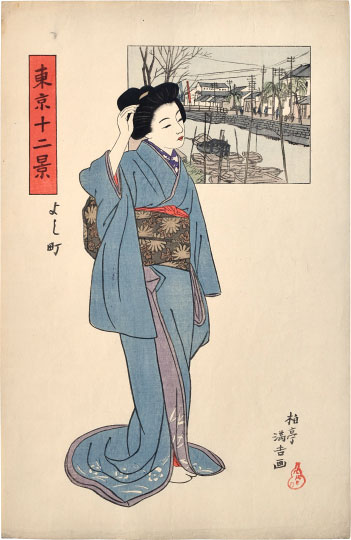

Ishii Hakutei
1882-1958
Twelve Views of Tokyo: Yoshicho
(Tokyo Junikei: Yoshicho)
cartouche with canal and telephone poles; signed Hakutei mankichi ga, with artist's seal Bonkotsu to, first published by Rokando, ca. 1910
oban tate-e 15 1/2 by 10 1/8 in., 39.4 by 25.6 cm
There have been some inconsistencies regarding the dating and publication credit for this series; Watanabe Shozaburo (1885-1862) is frequently credited as the publisher with dates generally ranging from 1914-1917. However, on the title page that accompanied the series, Hakutei explains that he commenced the series in 1910, releasing the first two designs before his departure for Europe. Upon his return it was suggested to him that he continue, perhaps by Nakajima Shigetaro (of Seikado) whom he identifies as the publisher. He does not mention that the first two prints were actually published by Takamura Kotaro of Rokando. He does, however, carefully distinguish these prints as not being based on his paintings, and compares them to the old ukiyo-e of Gototei (Utagawa) Kunisada (1786-1865). During the Meiji Period (1868-1912), it had increasingly become the norm for blocks to be carved based on completed paintings rather than a hanashita-e(preparatory drawing) provided by the artist. The distinction he is making is that the original designs for this series were made expressly to produce woodblock prints in the tradition of Japanese ukiyo-e.
Hakutei was clearly cognizant of the fact that he was trying to revitalize the old system. This was an intriguing experiment for him, given that Hakutei became one of the leading artists of the sosaku-hanga (creative print) movement, where the artist typically carved and printed his own works. This print series, published in the traditional hanmoto way by utilizing a professional block carver and a printer, was produced in a manner contrary to that independent spirit of sosaku-hanga. However, the sosaku-hanga movement was concerned with revitalizing the art and techniques of Japanese woodblock printing itself, as much as it was concerned with the expression of the independent artist carving and printing work himself. Although Hakutei closed his comments on the title page with a declaration of his intention to finish the series "without interruption," unfortunately, perhaps due to a lack of commercial success, or even his own waning interest in the traditional printing system, he abandoned the project with only three designs lacking.
This is the first print from the series, depicting the geisha Goromaru, thus the other prints may also illustrate geisha. In each composition, the figure is on a near empty ground, paired with a landscape cartouche typical of classic ukiyo-e. The bright red rectangular title cartouche is another quintessential ukiyo-e convention. While the geisha wear traditional kimono, the landscapes illustrate very contemporary views of Tokyo with somewhat dramatically contrasting details such as abundant telegraph poles, Western architecture, and distant smokestacks. This series captures a key transitional moment for the woodblock print genre. The theme is classic: views of beautiful women presented within parameters as compared to views of famous places. The design is classic: a beauty on a plain ground, and even the proportions of the landscape cartouche above are similar to ukiyo-e; but the moment is contemporary. In the nostalgic subject matter one sees the direction of shin-hanga (new prints) to come.
References:
Kato, Junzo, comp., Kindai Nihon hanga taikei, 1975-76, Vol. I, no. 20
Helen Merritt, Modern Japanese Woodblock Prints: The Early Years, 1990, pp. 122-124
Helen Merritt, and Yamada Nanako, Guide to Modern Japanese Woodblock Prints: 1900-1975, 1992, p. 43
Amy Reigle Stephens, gen. ed., The New Wave: Twentieth-Century Japanese Prints from the Robert O. Muller Collection, 1993, p. 137, no. 145
Kendall Brown, The Late Meiji to Taisho Eras, Early 1900s to 1926, in The Hotei Encyclopedia of Woodblock Prints, 2005, pp. 280-281
Amy Reigle Newland, and Hamanaka Shinji, The Female Image: 20th Century Prints of Japanese Beauties, 2000, p. 33, no. 1
Koyama Shuko, Beautiful Shin Hanga- Revitalization of Ukiyo-e, Tokyo Metropolitan Edo-Tokyo Museum, 2009, p. 16, no. 1-19
(inv. no. 10-1973)
price: Sold






